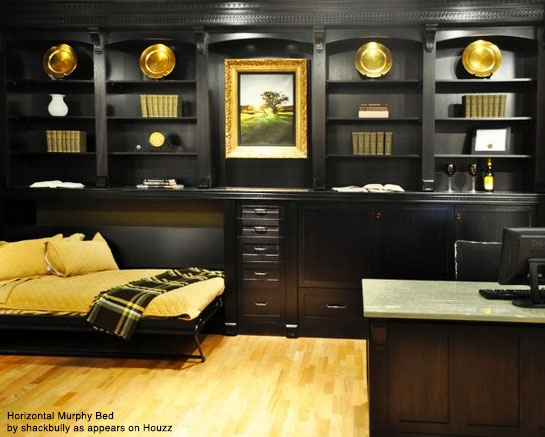Tag Archives: Design
Things We Like: Renovating Realities
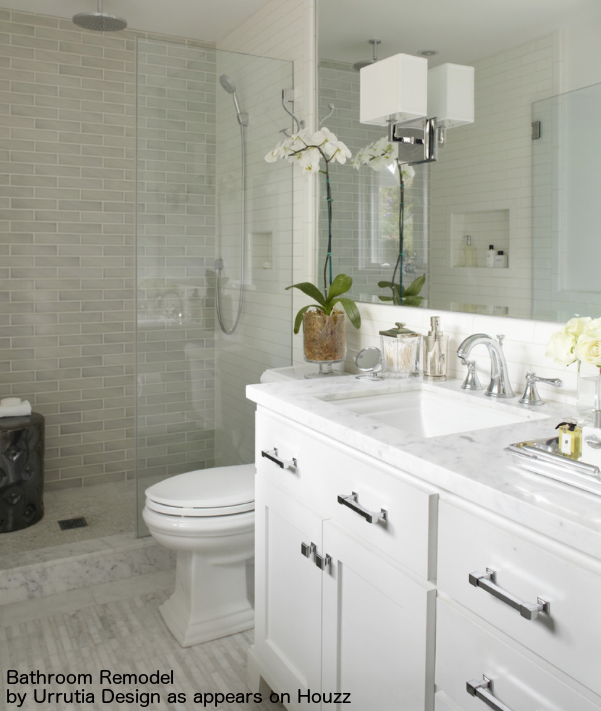
Post by Kyle St. Romain.
Here on the Charles Rogers Blog, we often talk about remodeling and renovating projects. Following my own advice, I recently began a project to renovate the en suite bathroom in my loft. While this isn’t a bedroom renovation, to me, an en suite is a central element to any luxurious bedroom.
Having watched countless home improvement television shows throughout my life, I never fully appreciated the Hollywood-magic going on behind the scenes of these projects. On TV, renovations are deceptively easy, even if there are some unexpected hiccups along the way; this is not the case in real life. I’m quickly realizing that even relatively simple home improvement projects take a lot of time and coordination — even if the actual work runs smoothly. While I’m still not finished with the project, heck, it hasn’t really even started yet; I want to share with you some of my early experiences to give you a better idea of the process. I will post future updates as the project progresses.
Phase 1: Brainstorming
The brainstorming session for my renovation began with a couple hours browsing through the bathroom galleries on Houzz, which really is a great resource for gathering design inspiration. Armed with my idea book of modern bathrooms that I would like to have for myself, I started looking for an interior designer to help me develop a cohesive plan for my specific space. In fact, it turns out that the designer even recommended putting together an idea book as a starting point to give them a better idea of what I am looking to accomplish. Let’s not jump too far ahead though. Before you can start working with a designer, you have to find and hire one.
Phase 2: Finding A Designer
My initial thought was to hire an interior design student. I figured this would allow me to get more work for my money as a student would be much more motivated than a professional to knock it out of the park. What the student lacked in experience would be offset by the additional time they spent on the project and their motivation to start building a real portfolio. A short email conversation with my alma mater’s design school quickly put an end to that plan. However, I did get a couple of recommendations for graduates in the area who do freelance projects. Ultimately, my plan did pay off.
Phase 3: Meeting With The Designer
Having checked out several of the recommendations, I settled on an interior designer that I thought would be a good fit for my project. After several conversations discussing price and process, he came to my home for the initial consultation/estimate about a week later. About a week after our meeting, I was presented with a design package, complete with the elevations for a custom vanity, recommended fixtures, and an overall scope for the project. This couldn’t have gone any smoother, but it still took a couple weeks just to get a plan.
Phase 4: Finding A Contractor
Having discussed the plan and budget with the designer, we both agreed that it would be more cost effective to manage the project myself and break it out into smaller parts. Without having to pay the extra overhead for a general contractor, I hope to keep the overall cost of the renovations down. The problem is that in Fort Worth, many contractors don’t have a web presence. And since I don’t know of anyone who has done renovations in the past, I had no base for referrals. After a bit of research, however, I was able to come up with a list of companies that I thought would be a good match for what I am trying to do.
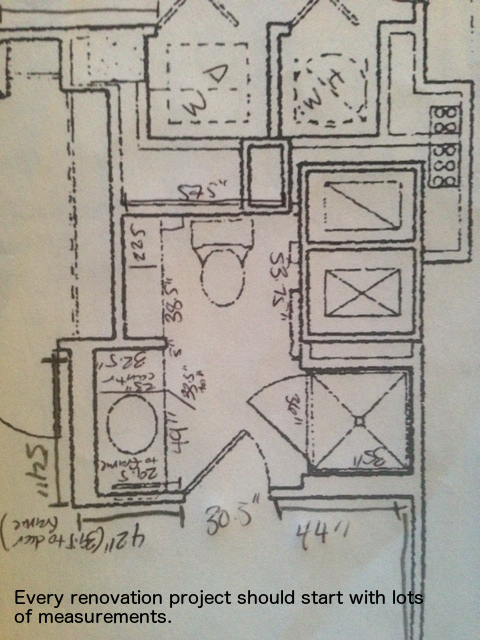
For my project I needed to find: (1) a tile layer/plumber; (2) a cabinet marker; (3) someone to build and install a barn door; and (4) a general carpenter/handyman who can handle everything else, including installing recessed lighting and relocating an overhead fixture.
The problem is that many of these companies seemed reluctant to just send out sales associates to estimate projects. Understandably, it costs them time and money to give these estimates, so they have to exercise some discretion. I solved this problem by visiting a couple companies in-person to discuss my plans and set up an appointment that way. While this really isn’t that big of a deal, it does add more time to the project. Further delaying the project is that once the contractor comes to the site, it takes them about another week to draw up an estimate for the project. I anticipate further delays in fitting my project into their existing schedules.
Next time you’re watching a home improvement show, notice how on TV all the plans are drawn up almost instantly, and there seems to be a whole construction company waiting for the green light. This is not the case in real life.
Moving Forward
Still waiting on a couple bids back from contractors, no real work has started yet. Once approved, the custom cabinets will take approximately 5 weeks to build, which I anticipate to be the biggest delay in the project. While I wish that things were moving along quicker, the extra time has given me the opportunity to refine the scope of my renovation. I’m always sure to ask for input from everyone who comes out to estimate the project; just to be sure nothing goes overlooked.
Even though I’m not making any major structural changes to my small en suite bathroom, the costs add up quickly. A couple fixtures, new cabinets, tile, labor, and a drain pan and frameless door for the shower are much more expensive than I anticipated. Hopefully this work will pay off, and I will keep you updated about the progress of this project as it unfolds.
Things We Like: Four-Poster Beds

Post by Kyle St. Romain.
Throughout history beds have been used as a symbol of wealth – the more ornate and grand the bed, the wealthier its owner. Early in the evolution of the bed, anything raised from the floor was thought to be luxurious enough. After all, it beat sleeping on the floor! In the 13th century, however, the idea of a bedchamber was becoming more popular, i.e., enclosing the sleeping area with fabrics. The earliest bedchambers suspended fabrics from the ceiling to create a private sleeping environment. This concept later evolved into a four-poster bed, thought to have first been used in Austria, which created a more luxurious look and feel. Featherbeds, woolen blankets, and silk sheets were also introduced around this time, which made the beds functional and beautiful.
As trade and craftsmanship continued to grow, so did the bed. No longer a raised assemblage of wooden planks, beds had become works of art intricately carved, gilded with gold, and adorned with fine fabrics and precious stones. Four-poster beds were also quite large, with the Great Bed of Ware (which can be seen at the Victoria and Albert Museum) measuring a full 11 feet square. A bed of that size will make you second-guess whether a California King is really big enough!

The traditional four-poster bed would have been made from thick oak posts (up to 18 inches in diameter in some of the grandest examples), attached to the floor (not the bed), and connected by a series of rails along the top. Today, the posts of four-poster beds are usually connected to the bed itself, and come in almost every style imaginable — limited only by your taste and budget.
If you’re considering a four-poster bed, Charles Rogers makes a couple different styles of canopy beds made out of iron that can be draped in fabrics to create a very luxurious look. You can also check out the Houzz gallery to see how other people have dressed up their four-poster beds.
Things We Like: 2014 Color of the Year
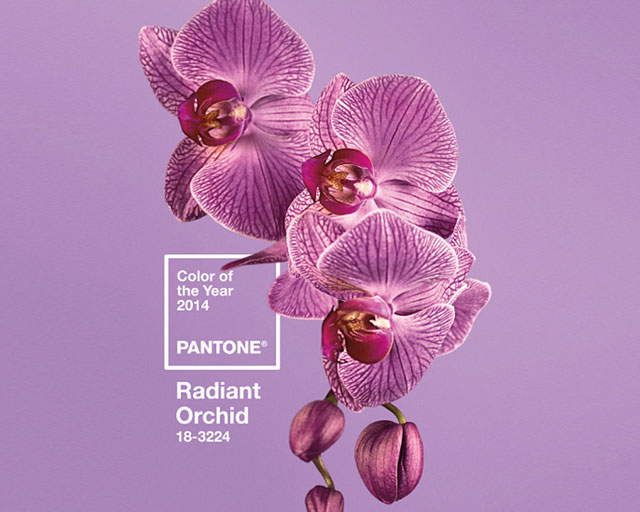
Post by Kyle St. Romain.
Pantone recently announced its color of the year for 2014: Radiant Orchid, replacing Emerald from 2013. You can read Pantone’s spring 2014 fashion color report. Sherman Williams followed suit announcing a more muted shade of purple called “Exclusive Plum” as its color of the year.
It shouldn’t be too surprising that purple is the consensus color considering that these decisions are made after surveying designers, manufacturers, and retailers throughout the world about the colors they plan to use in the coming seasons. The color of the year is more a formal announcement of the direction that’s already been decided, not necessarily something taking the design world by surprise (even if it is news to the rest of us).
With the announcement of the new color, however, you’re sure to notice purples popping up in all sorts of unexpected places. Expect the fashion industry to showcase the “it” colors in their spring catalogs, and interior designers tend to do the same. A little tip I learned in my interior design class is to thumb through Neiman Marcus’ spring catalogs for inspiration on how to create a color palette with that year’s trendy colors. I’m sure this tip holds true for other retailers as well. You can also use Adobe’s Kuler app to create a stunning color palette effortlessly.
Here’s a sample of a compound color palette based off of Radiant Orchid.
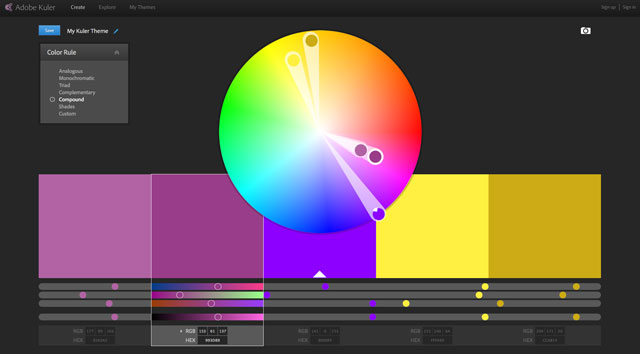
While you may be hesitant to incorporate such a vibrant purple with your personal style, you shouldn’t be. Radiant orchid, and all shades of purple for that matter, is surprisingly versatile. Radiant Orchid looks great accented with rich golds, sea greens, whites, and other shades of purple. It’s also quite simple to add a splash of Radiant Orchid in your home using a freshly painted accent wall, newly upholstered furniture, bed sheets, or a bright new throw rug. Whatever it is, it won’t be hard to find almost anything household or fashion related in Radiant Orchid this year.
The only consideration left is: How you feel about the color? As a TCU alumni, I couldn’t be more thrilled that purple is the color of 2014. While Radiant Orchid isn’t the same deep purple as TCU’s, it is nonetheless a very acceptable to me. A lot of the clothing I own winds up being some shade of purple, and now I may seem a bit trendier (if only for a year). I hope you enjoy the color of 2014 as well. If not, there’s always 2015.
If you’d like to read more about upcoming color trends, be sure to check out Pantone’s Spring 2014 Fashion Color Report.
Things We Like: How To Make A Luxury Hotel Bed At Home
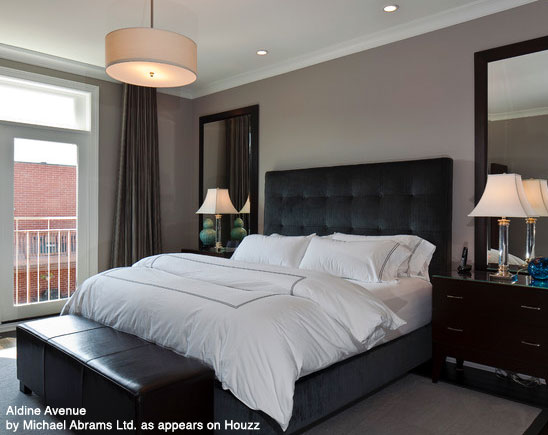
Post by Kyle St. Romain.
Beds are big business at hotels, so much so that many hotel chains have branded their own line of mattresses and bedding. Starwood’s Westin Hotels started the trend back in 1999, and a half a dozen other have followed suit, including: The Four Seasons, The W, Hyatt, Sheraton, Marriot, Ritz-Carlton, and Hilton. After all, the goal of any luxury hotel should be to sell you the best night’s sleep you’ve ever had — even if it’s back at your home.
If you’re looking to recreate a hotel sleeping experience at home, I’ve put together some of the essential components to help you create your own five-star bed at home.
- First, you need a Firm Mattress. The mattress is your first big decision that will affect your quality of sleep. I generally err on the side of more firm than soft when choosing a mattress, since you can always add additional elements to soften it up. You can’t, on the other hand, make a soft mattress feel firmer.
- Next, you’ll want to protect your mattress with a Felt Mattress Protector. This will protect the mattress from stains and spills, and add an additional layer of support.
- The biggest secret to making a five-star bed at home is the Featherbed. Think of this as a sort of a half-mattress that goes over the mattress protector but under the sheets. There are all sorts of options to choose from when selecting a featherbed, but you should generally go with something that is baffled and has a relatively high feather count.
- The Fitted Sheet is the first layer that your body will actually come into contact with, and it goes over the mattress, protector, and featherbed. You can usually buy the fitted sheets in a set with the flat sheet and pillowcases. When choosing sheets, go for something with a relatively high threat count made out of natural materials.
- The Flat Sheet is what you will sleep directly under, and will usually match the fitted sheet underneath.
- The final element of a luxury bed is the comforter. The type of comforter you choose depends mostly on your climate and personal preferences. Some people like to have both a lighter summer comforter and a heavier winter comforter to accommodate the change in temperature. You may also want to put another flat sheet or throw over the top of your comforter to complete the look — maybe even with a chocolate on top. Turn down service anyone?
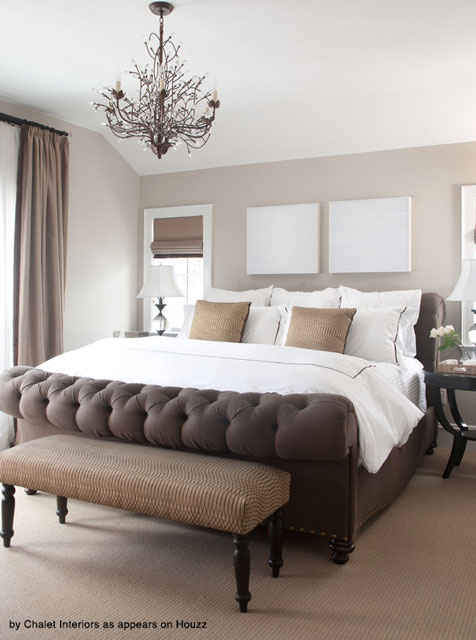
So, next time you wake up at a hotel feeling like you just had the best night’s sleep of your life, take a minute to see exactly what elements went into making the bed. And with so many hotels selling their own brands of bedding collections, you can even recreate every detail in your own home down to the mattress itself.
Before we go, here’s an interesting fact of the day: Did you know that Charles P Rogers sold more beds to luxury hotels in its first 100 years of business than any other company? Pretty impressive if you ask me.
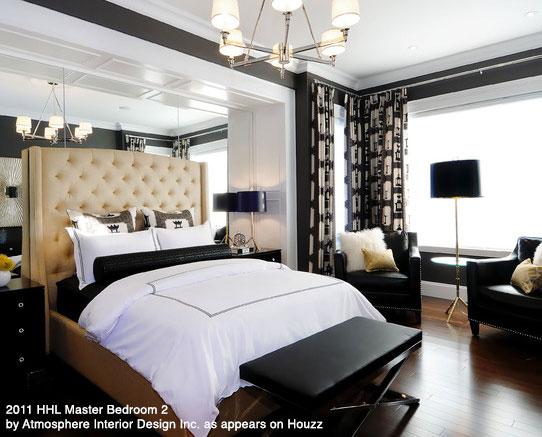
Things We Like: Murphy Beds
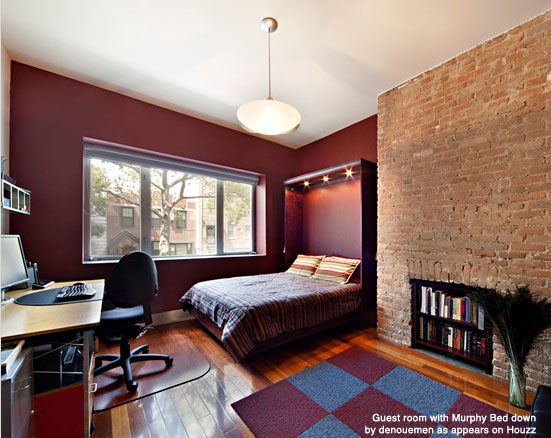
Post by Kyle St. Romain.
William Lawrence Murphy is the man credited with the first Murphy bed design. After all, it is called a Murphy bed. As the story goes, he developed the fold away bed as a way to skirt social standards in the early 1900s. Back then, women were forbidden from entering a man’s bedroom. With a Murphy bed, however, the same space that would otherwise be used as a bedroom was easily transformed into something more socially appropriate, like a sitting parlor. The rest is history.
Today, Murphy beds are epitome of multitasking, something valued highly in today’s ever-changing world. Don’t have enough space to dedicate to a bedroom, but often host out of town guests? A Murphy bed is a great way to maintain the functionality of your home office or living space, while giving you the flexibility to comfortably accommodate the occasional sleepover guests. Murphy beds help you make the most out of your living space without sacrificing comfort or style.
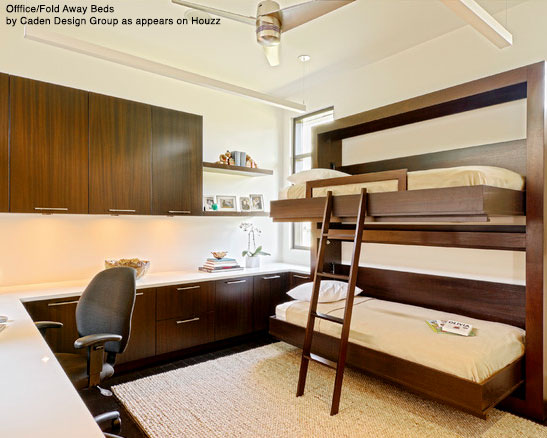
I’ve always had a negative feeling associated with Murphy beds, like: “Why can’t you just get a regular bed?” However, Murphy bed design has come a long way, and there is a plethora of options to chose from. Today’s innovative Murphy bed designs are able to accommodate almost any style home décor or floor plan. Did you know they make horizontal Murphy beds? What about Murphy beds for pets? Yes, they make those too.
A lot of neat details I see in some of the higher end looking rooms that feature a Murphy bed is attention to detail as to where everything goes both when the Murphy bed is stowed up, and when it’s folded down. Instead of having to push furniture out of the way when you fold out your Murphy bed, the more cleverly designed living spaces have an almost hidden built in space waiting to accept whatever piece of furniture needs to be moved. Everything has a place.
As always, the best way to see just how cool some of these Murphy bed rooms are you should check out the Murphy Bed gallery on Houzz. Some of them are really quite impressive.
